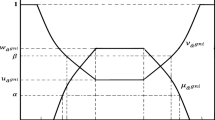Abstract
As a special intuitionistic fuzzy set on a real number set, intuitionistic fuzzy numbers (IFNs) have the best capability to model ill-known quantities. The purpose of this paper is to investigate generalized intuitionistic fuzzy numbers (GIFNs). The weighted possibility, necessity and credibility measures of generalized trapezoidal intuitionistic fuzzy numbers (GTIFN) are introduced, and expected value of GTIFN has been formulated. By employing the possibility and necessity measures of GIFN, the single period multi-product manufacturing generalized intuitionistic fuzzy inventory models is transformed into an equivalent deterministic problem. The transformed problem has been solved by soft computing technique. Finally, the proposed method is illustrated with one numerical example.








Similar content being viewed by others
References
Atanassov KT (1986) Intuitionistic fuzzy sets. Fuzzy Sets Syst 20:87–96
Atanassov KT (1983) Intuitionistic fuzzy sets, VII ITKR Session, Sofia Sci. Techn. Libary of Bulg. Acd. of Sci., Bulgaria
Ban AI (2004) Intuitionistic fuzzy valued possibility and necessity measure. In: Enghth International Conference on IFS 10, pp 1–7
Burllo P, Bustince H, Mohedano V (1994) Some definition of intuitionistic fuzzy number. In: Proceedings of the first workshop on fuzzy based expert system, vol 1, pp 28–30
Chakraborty D, Jana DK, Roy TK (2014) A new approach to solve intuitionistic fuzzy optimization problem using possibility, necessity and credibility measure. Int J Eng Math 20:1–12
Chakraborty D, Jana DK, Roy TK (2014) Arithmetic operations on generalized intuitionistic fuzzy number and its applications to transportation problem. Opsearch (Springer) 1:1–34
Dubois D, Prade H (1980) Fuzzy sets and systems: theory and applications. Academic Press, New York
Dubois D, Prade H (1988) Possibility theory. Academic Press, New York Press-London
Garai T, Chakraborty D, Roy TK (2016) A multi-item periodic review probabilistic fuzzy inventory model with possibility and necessity constraints. Int J Bus Forecast Market Intell 2:175–189
Garai T, Chakraborty D, Roy TK (2017) Expected value of exponential fuzzy number and its application to multi-item deterministic inventory model for deteriorating items. J Uncertain Anal Appl 5:1–20
Goswami A, Chaudhuri SK (1991) EOQ model for inventory with a linear trend in demand and finite rate of replenishment considering shortages. Int J Syst Sci 22:181–187
Khouja M, Mehrej A (1995) Economic production lot size model with variable production rate and imperfect quality. J Comput Oper Res 45:1405–1417
Klir JK (1999) On fuzzy set interpretation of possibility. Fuzzy Sets Syst 108:263–273
Kumar M (2014) Applying weakest t-norm based approximate intuitionistic fuzzy arithmetic operations on different types of intuitionistic fuzzy numbers to evaluate reliability of PCBA fault. Appl Soft Comput 23:387–406
Lau H, Lau A (1995) The multi-product multi-constraint newsboy problem: application, formulation and solution. J Oper Manag 13:153–162
Li DF (2008) A note on using intuitionistic fuzzy sets for fault-tree analysis on printed circuit board assembly. Microelectron Reliab 48:17–41
Li DF (2010) A ratio ranking method of triangular intuitionistic fuzzy numbers and its application to MADM problems. Comput Math Appl 60:1557–1570
Li X, Liu BA (2006) Sufficient and necessary condition for credibility measures. Int J Uncertain Fuzziness Knowl Based Syst 14:527–535
Li DF, Nan JX, Zhang MJ (2010) A ranking method of triangular intuitionistic fuzzy numbers and application to decision making. Int J Comput Intell Syst 3:522–530
Liu B (2006) A survey of credibility theory. Fuzzy Optim Decis Mak 5:387–408
Liu B, Liu KY (2002) Expected value of fuzzy variable and fuzzy expected value models. IEEE Trans Fuzzy Syst 10:445–450
Maity K, Maiti M (2007) Possibility and necessity constraints and their defuzzification-A multi-item production-inventory scenario via optimal control theory. Eur J Oper Res 177:882–896
Nagoorgani A, Ponnalagu K (2013) An approach to solve intutionistic fuzzy linear programming problem using single step algorithm. Int J Pure Appl Math 86:819–832
Nahmias S, Schmidt PC (1997) An efficient heuristic for the multi-item newsboy problem with a single constraint. Naval Res Logist Q 31:463–474
Panda D, Kar S, Maity K, Maiti M (2008) A single period inventory model with imperfect production and stochastic demand under chance and imprecise constraints. Eur J Oper Res 188:121–139
Pedrycz W, Chen SM (2011) Granular computing and intelligent systems: design with information granules of higher order and higher type. Springer, Heidelberg
Pedrycz W, Chen SM (2015) Information granularity, big data, and computational intelligence. Springer, Heidelberg
Sana S, Goyal KS, Chaudhuri SK (2004) A production inventory model for a deteriorating item with trended demand and shortage. Eur J Oper Res 157:59–64
Sarkar B (2011) A production-inventory model with probabilistic deterioration in two-echelon supply chain management. Appl Math Model 37:3138–3151
Vairaktarakis GL (2000) Robust multi-item newsboy models with a budget constraint. Int J Prod Econ 66:213–226
Wan SP (2013) Multi-attribute decision making method based on possibility variance coefficient of triangular intuitionistic fuzzy numbers. Int J Uncertain Fuzziness Knowl Based Syst 21:223–243
Wan SP, Dong JY (2015) Possibility method for triangular intuitionistic fuzzy multi-attribute group decision making with incomplete weight information. Intent J Comput Intell Syst 7:65–79
Wang JQ, Zhang Z (2019) Aggregation operators on intuitionistic trapezoidal fuzzy number and its application to multi-criteria decision making problems. J Syst Eng Electron 20:321–326
Wu J, Liu YJ (2013) An approach for multiple attribute group decision making problems with interval-valued intuitionistic trapezoidal fuzzy numbers. Comput Ind Eng 66:311–324
Xu ZS, Yager RR (2006) Some geometric aggregation operators based on intuitionistic fuzzy sets. Int J Gen Syst 35:417–433
Yager RR (1992) On the specificity of a possibility distribution. Fuzzy Sets Syst 1:3–28
Zadeh LA (1965) Fuzzy Sets. Inf Comput 8:338–353
Zadeh LA (1978) Fuzzy sets as a basis for a theory of possibility. Fuzzy Sets Syst 1:3–28
Author information
Authors and Affiliations
Corresponding author
Rights and permissions
About this article
Cite this article
Garai, T., Chakraborty, D. & Roy, T.K. Possibility–necessity–credibility measures on generalized intuitionistic fuzzy number and their applications to multi-product manufacturing system. Granul. Comput. 3, 285–299 (2018). https://doi.org/10.1007/s41066-017-0067-0
Received:
Accepted:
Published:
Issue Date:
DOI: https://doi.org/10.1007/s41066-017-0067-0




